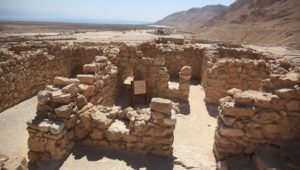The Enigma of Qumran, Hershel Shanks, Biblical Archaeology Review (24:01), Jan/Feb 1998.
Four archaeologists assess the site
If you want to understand how archaeologists think, how they reason, how they work, how they interpret finds—and why they sometimes disagree—you will enjoy this discussion among four prominent archaeologists who know as much about Qumran and its excavation as can be known today.
Long associated with the Dead Sea Scrolls found in nearby caves, Qumran was excavated between 1951 and 1956 by the late Father Roland de Vaux of the École Biblique et Archéologique Française in Jerusalem. De Vaux died in 1971 without publishing a final report.
For some, Qumran is the key to understanding the scrolls. But for everyone it is a fascinating site in its own right as scholars struggle to understand it—and to learn from it.
The participants in this discussion, three Israelis and an American, are all field archaeologists, or dirt archaeologists, as they are sometimes called. Joseph (Yossi) Patrich is associate professor of archaeology at the University of Haifa; Hanan Eshel is senior lecturer in archaeology at Hebrew University and Bar-Ilan University; Yizhar Hirschfeld is lecturer of classical archaeology at Hebrew University; and Jodi Magness is associate professor of classical and Near Eastern archaeology at Tufts University. BAR editor Hershel Shanks moderates the discussion, which was held in Jerusalem last summer.
Read the rest of The Enigma of Qumran in the online Biblical Archaeology Society Library.




